Brasília at Midnight
by Silas Martí
Latin America’s powerhouse has buckled, and with startling speed. Seventy years of progress and downfall have taught Brazil’s artists about survival — but this crisis may put off the future forever
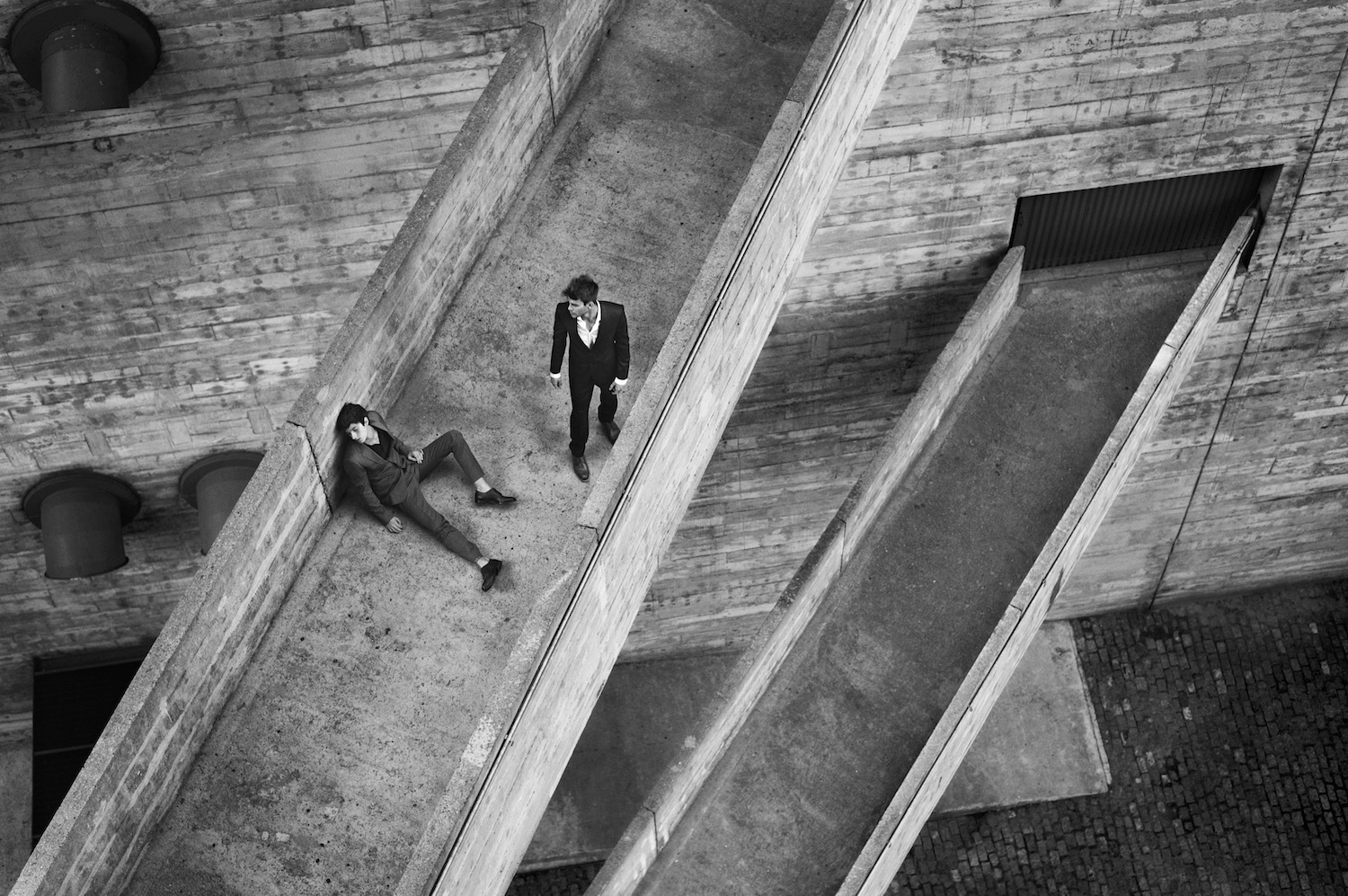
Lina Bo Bardi. SESC Pompeia, São Paulo.
Photo: Olaf Heine. Courtesy Camera Work Photogalerie, Berlin.
This article appears in Even no. 4, published in summer 2016.
I.
It was a swanky house in the heart of the Jardins, one of São Paulo’s posh districts. While some guests twerked frenetically in the living room-cum-dance floor surrounded by expensive works of art, others made cocaine runs to the nearest bathroom. Outside, in the unseasonably sizzling weather, some got naked and jumped into the big, bright pool framed by tropical shrubbery. The sound of cocktail shakers over owing with caipirinhas sometimes pierced the heavy bass of the music coming from the house. There were artists, gallerists, collectors, and writers like myself. We left as the sun began to rise, and this was only a few days into this year’s SP-Arte week, packed with museum openings, events, and the headline art fair. It would have seemed like any other art world shindig were it not for the performance that began to erupt just outside the gate. As guests stumbled out the door, still in a haze, an artist began to shout. “Não vai ter golpe,” he screamed, his voice bouncing off the high walls of the fortress-like mansions all around. There will be no coup.
In April that slogan was a kind of mantra for the die-hard left, orphaned by Dilma Rousseff, Brazil’s president, and Luiz Inácio Lula da Silva, her scandal-shaken predecessor. Their opponents, who like to dress in green and yellow, had their own slogans too. “Tchau, querida,” they chanted — “bye, sweetie,” a phrase Lula said to Rousseff in a wiretapped phone call — as they marched for Rousseff’s immediate deposition and replacement with a more efficient government, capable of steering the ruined economy back on track. The derailing of Brazil is baffling even to those of us who witnessed it. It is hard to understand that the euphoria experienced over the past few years is now gone, and that what seemed a promising future has turned into a convoluted mess.
There seems to be no doubt: Brazil is its old, violent, unstable self again. As I began to write this article, workers in Brasília, the country’s Oscar Niemeyer-designed modern masterpiece of a capital, were busy assembling a wall in front of the towers of Congress to divide protesters in favor of the Rousseff government from those against. The crooked, flimsy thing resembles the bizarre state of affairs in this nation, the divided lawn a metonym for the now divided country. There are no friendly gatherings, no family reunions, no pauses for small talk at work that don’t slide into an awkward moment of reckoning. Is he on our side or their side? Some political pundits see this as a simple matter of class division and struggle. The rich want her out, the poor want her to stay put.
The week after São Paulo’s art fair came to a close, the lower house of Congress voted to oust the president, the first step in a series of legal proceedings that have cut short Rousseff’s mandate and installed in her place politicians substantially more corrupt than she is. The country watched stunned on April 17 as each deputy cast his vote against Rousseff, with speeches that often verged into wild absurdity. (One member voted to impeach “for peace in Jerusalem”; another did it “as tribute to my only and true riches, my daughters”; a hard-right deputy from Rio voted in the name of a colonel who led a torture squad during the dictatorship.) It was like the final match of the World Cup: television screens were blaring everywhere, and when the decisive vote came in, reworks could be heard all around town and, in usually pacific wealthier neighborhoods, some even banged pots and pans — the practice now widely known as panelaço — on their terraces.
In the halls of SP-Arte, even before the vote, gallerists and artists were seen bickering about politics, as collectors deliberately shunned works that in any way alluded to a preference for the president’s permanence in power. Artist Lourival Cuquinha, who spelled the word golpe (“coup,” in Portuguese) with stacks of coins fastened to a wall at the fair, told me two buyers passed on his piece when they managed to connect the dots and spell it out. It is difficult to understand how collectors in this country can hold artists like Cildo Meireles and Antonio Manuel — two of the most vocal opponents of the 1960s military dictatorship — in such high regard, seeing that they now deliberately resist any artwork that may read as political.
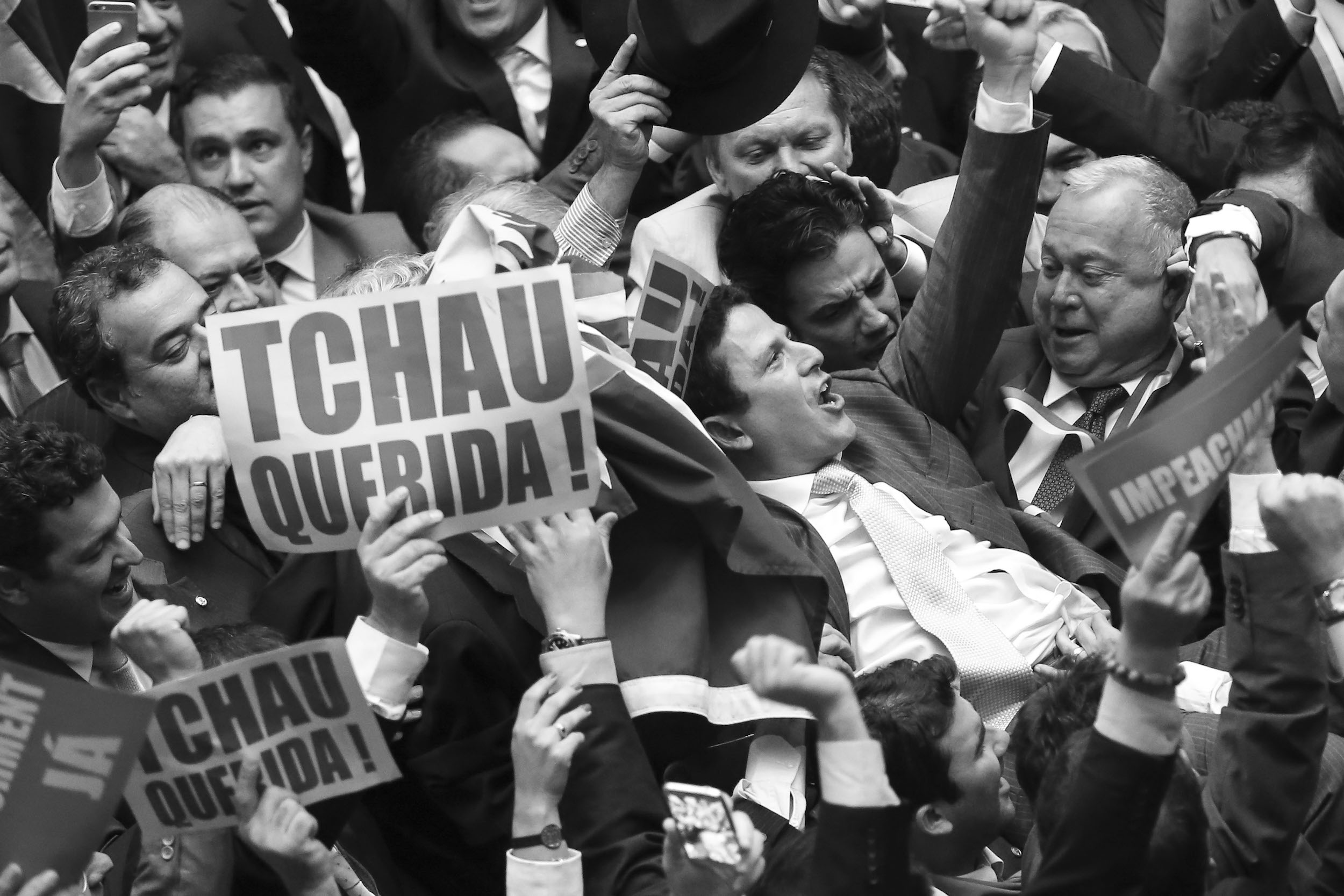
Referring to the impeachment proceeding as a coup d’état is a political stance many artists have taken — and one that Jochen Volz, curator of the next Bienal de São Paulo, has supported. The German has explained that his selection of artists for the biennial has changed significantly since Congress began its push to shove Rousseff out of her office at the Palácio do Planalto. Much like the class divisions carving their way through the political spectrum with ever sharper force and brutality, the Brazilian art world now stands divided between those challenging the current moment — many of them black and up-and-coming, like Dalton Paula, Jaime Lauriano, and Bruno Baptistelli — and those who simply hope that the turmoil won’t drive sales down. The most notable artist of the latter category is the photographer Vik Muniz, who used his recent tenure as curator of MoMA’s Instagram account to complain about Rousseff.
As far as the market goes, SP-Arte’s director, Fernanda Feitosa, refused to talk about politics with me. She said it had nothing to do with the event—this when the fair has been partly funded with public money ever since its inception, and has benefited from hefty tax cuts granted by the government every year. As the event came to a close, Feitosa posted on her Facebook account that the week had been marvelous, and that the parties were the best. I remember indeed another party. An art adviser based between New York and São Paulo rented out the penthouse of the Tivoli hotel in the Jardins to launch yet another online art platform. Drinks were fabulous. The view from up top was just stunning. But I couldn’t gather myself to literally jump for joy when the host asked me to join in for a photo-op.
When Carnival rolled around last February, with the usual slew of nearly naked and drunken dancers flooding the streets of every major city in the country, an article in the Economist suggested, a little bemusedly, that we were “partying on a precipice.” Over the past seven years, covers of the same magazine have illustrated Brazil’s dramatic fall from grace. In 2009, the Christ statue that looms over Rio de Janeiro was montaged as a rocket blasting off into space from the summit of Corcovado. Four years later, in 2013, another cover depicted the statue tumbling downwards head first, asked if Brazil had “blown it.” The answer came recently, when the April 2016 issue showed Christ the Redeemer holding up an SOS sign, above a headline of Brazil’s “betrayal” by its politicians.
Seven years ago, the Brazilian economy was growing at an annual rate of 5%, reaching a height of 7.5% by 2012. The discovery of deep-sea oil reserves crowned Lula’s second term in office, and gave us the impression that the country was set on a new path. A boom in commodity prices sustained Brazilian exports, and therefore the upper class, while the abundant supply of credit going around fueled a wave of rampant consumption in the lower classes. It was a miraculous win-win for all, the heyday of Brazilian democracy achieved, despite all disbelief, under the administration of a former factory worker. Lula was the very portrait of the Brazilian underdog who had made it to the most powerful position in the nation. To top it all off, Brazil was awarded the chance to host the 2014 World Cup and this year’s Olympics, the opportunity it had always sought to prove to the world it is more than the land of soccer, voluptuous bikini-clad women, and caipirinhas by the sea.
The tide began to turn when Dilma Rousseff took office. Lula groomed his chief of staff to be his successor after some of his cronies in the Workers’ Party (PT) were found guilty of corruption in a vote-buying scandal known as the Mensalão (“Big Monthly Payoff”). Unprepared for the presidency, Rousseff struggled to make ends meet as other emerging economies slowed and exports short-circuited, bringing the commodity boom to a halt. Over the past two years, unemployment and inflation have risen; over a million people lost their jobs last year, and the economy is expected to shrink by about 3.8% by the end of 2016. The Brazilian real has lost about a quarter of its value against the dollar, angering a middle class now accustomed to vacationing in Miami and hoarding outlet goods onto planes back home. The Rousseff years, coming to an abrupt close with her impeachment, saw the ruin of consumerism, even though the country’s lower classes still benefit from the social assistance programs Lula introduced. It is this point that explains why the class divide has sharpened lately, leading to the showdown in Congress this April, an episode that seems to have pushed Brazil back into stalemate.
It may seem silly, but some, like the artist Ernesto Neto, also attribute the beginning of the debacle to the psychological damage caused by the Brazilian national soccer team’s disastrous defeat against Germany in the 2014 World Cup semifinal. The entire nation, after a month of hosting a vintage edition of the tournament, turned its eyes to Belo Horizonte — where the Seleção was crushed, 7 to 1. No one had seen anything like this defeat in decades. Even Brazil’s prowess on the soccer pitch was no more, and the Brazilian dream, if it ever blossomed, had now decidedly wilted.
And then there is Operação Lava Jato: “Operation Car Wash,” a federal police investigation that has exposed the biggest corruption scandal the country has ever seen, involving figures in all political parties and at all levels of government. The Lava Jato disaster has cast the darkest shadows on the president’s second term and has thrust Petrobras, the state-owned oil company, into near bankruptcy after the revelation that most of its reserves were diverted to line the pockets of corrupt politicians and executives. (It is important to note that while almost every leading politician has been caught in the crosshairs of Lava Jato, Rousseff herself has not been accused of corruption. Her impeachment rests on the flimsier grounds that she violated fiscal responsibility laws.)
On May 12, the Senate followed the Chamber of Deputies and voted to impeach the president. Although she remains in residence in Niemeyer’s sumptuous Palácio da Alvorada, she has been replaced in office by her vice president, Michel Temer — who is not a member of Lula and Rousseff ’s PT, but of the ideologically slippery Brazilian Democratic Movement Party (PMDB). Temer himself and much of his new cabinet, made up of men only, face corruption allegations of their own. One of the new government’s first acts was to eliminate the ministries of human rights and of culture. The extinction of the latter caused enormous outcry in the country’s artistic community, and government buildings were invaded and occupied all across Brazil. Rio’s Palácio Gustavo Capanema, one of the first modernist buildings in the nation, designed by Le Corbusier and Niemeyer, became the strongest cell of resistance. Musicians such as Caetano Veloso stopped by to sing and declare their outrage at Temer’s administration. Days later, on May 22, the interim president backtracked on his decision and reinstated the ministry of culture. After the refusal of five women, he named a man as head of the department.
As a Brazilian, living through the last year of crisis has felt like muddling through a state of collective delirium. Each day we wake up to learn the world has just ended, or else reappeared in a more violent, confused state. What happens to artists when the ground beneath their feet suddenly turns to quicksand? And what happens to arts institutions caught between an imploding public sector on one hand, and on the other a collecting class whose richest members may be heading to jail?
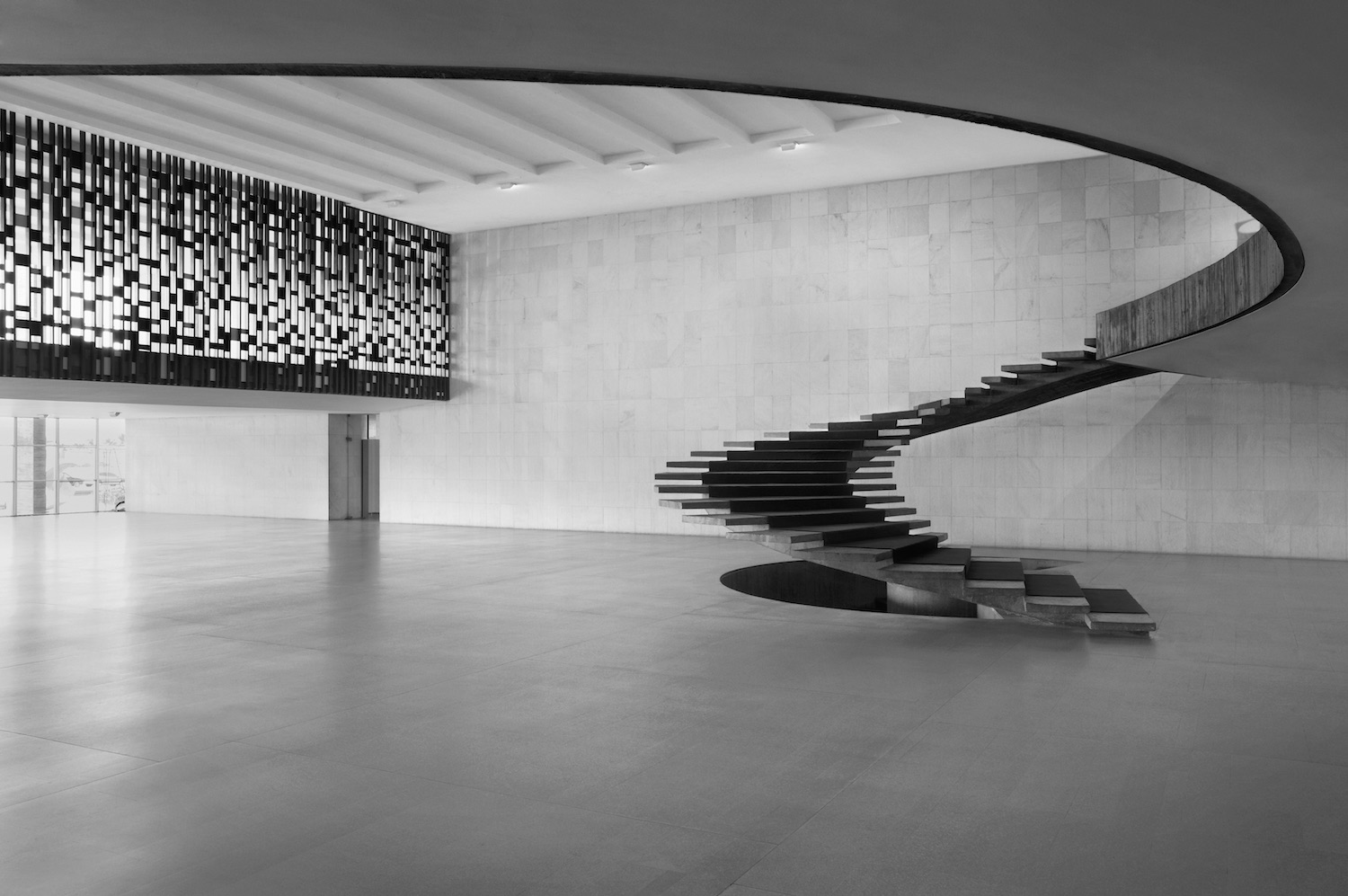
II.
Years before the military took control of Brazil in the coup d’état of 1964, a general sat next to Oscar Niemeyer, the architect of Brasília, on a flight to what was then still a construction site. He asked the city’s planner if he was going to build beautiful, classic palaces to serve as the new seat of government. Niemeyer replied with another question, asking if at war the general would prefer ancient weapons or modern ones.
Niemeyer’s delirious capital came into existence in a rare moment when Brazilian intellectual thought seemed at last to connect with the political reality of the nation. Neither the general nor the architect imagined that just four years after its inauguration in 1960, Brasília would fall into the hands of a brutal regime, out of sync with the audacity of the architecture’s modernist contours and sweeping curves. That Niemeyer likened the capital to a weapon nonetheless underscores something at the base of Brazilian society: a desire to push forward at all costs. The land of the future, as Stefan Zweig called Brazil in the 1940s, has a strange obsession with cutting ribbons at inaugurations, rather than making sure foundations and structural pillars will hold.
Behind Brasília and so many other of Niemeyer’s most extravagant projects was the political muscle of Juscelino Kubitschek, former governor of Minas Gerais, who rose to the presidency in 1956 with a desire to catapult Brazil into the future. His vision was summed up in the slogan “50 years in five,” promising a dramatic propulsion of old, agrarian Brazil into a new economy, filled with car factories and highways. The president’s dream found its visual translation in Niemeyer’s drawings, and all roads led to Brasília as a beacon of the future.
Shaping nature in accordance with Niemeyer’s voluptuous concrete waves, Roberto Burle Marx was the landscape designer of choice. While both Niemeyer and Burle Marx were very much indebted to the tradition of Le Corbusier, they twisted and bent his machines for living to create more supple spaces, contoured to the mountains and bays outside. Anyone who has been to Rio will understand the modernist architecture that comes from there. In São Paulo, modernism gained traction with other shapes, despite boasting the same philosophy. João Batista Vilanova Artigas, Lina Bo Bardi, and Gregori Warchavchik built the schools and houses of the future: brutalist, right-angle contraptions that were a radical departure from the colonial pastiche and neoclassical endeavors that dominated much of the urban fabric. With minuscule bedrooms and ample kitchens and living rooms, these were houses with an ideology: no isolation allowed, coexistence at its fullest.
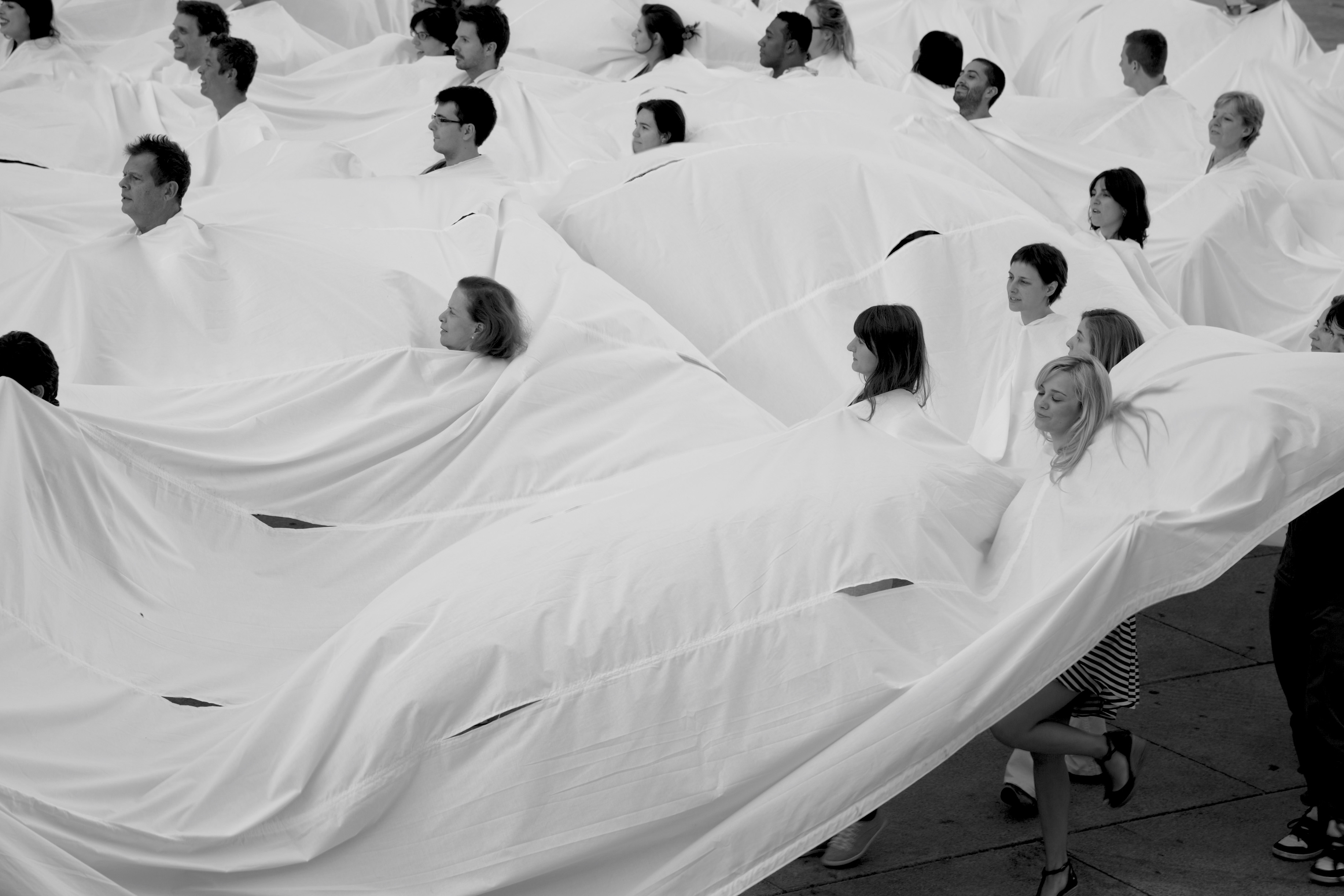
These left-leaning dreams were soon crushed by the military regime. Dissidents, including the future president herself, were tortured and silenced. The country’s most brilliant minds — like the musical heroes of Tropicália, Caetano Veloso and Gilberto Gil — went into exile. Niemeyer moved to Paris, and the leaders of São Paulo’s modernist revolution lost their teaching positions. Artists left too: Lygia Clark to Paris, Hélio Oiticica to New York. Those who stayed behind worked between the lines to corrode the silencing mechanisms of the military regime. Cildo Meireles printed questions about the brutality of the dictatorship — such as “Who killed Herzog?”, in reference to a disappeared journalist — on Coca-Cola bottles and banknotes. Artur Barrio shocked Belo Horizonte by wrapping raw meat in bundles of white cloth and scattering them in the woods along a river, alluding to those who had disappeared, and most likely perished, at the hands of the military.
In 1968, the regime adopted Institutional Act No. 5, a notorious law that wiped out civil liberties and ignited the engines of torture centers all around the country. The American government suspended aid to Brazil (at least for a time); the US, France, Sweden, Mexico, and other nations boycotted the Bienal de São Paulo, as did many foreign artists. For artists in Brazil, the situation had escalated decisively. It was that year Lygia Pape created her Divisor, for which performers poked their heads through holes in a huge piece of fabric and walked around Rio, their bodies invisible under a huge white cloth. Thoughts, under military rule, were severed from actions.
Little changed until the 1980s, a time of the so-called democratic opening. The generals faltered; the country held free elections in 1985; a new reality had been conquered. Brazilian art of the late 1980s and 1990s, then standing on more solid ground, seemed to take flight. Lygia Clark and Hélio Oiticica, now household names in the Latin American pantheon, began to gain traction on the global stage as brilliant examples of art that survived the military regime, even while it questioned the very structure of the society that gave rise to it.
There was a glitch in 1992; the president (and now senator) Fernando Collor was impeached. But the democratic awakening persisted, and artists such as Adriana Varejão, Nuno Ramos, Leda Catunda, Jac Leirner, and Vik Muniz rose to prominence as the country’s first generation working within an established gallery system. When a new currency, the Brazilian real, was introduced in 1994 — putting an end to a period of hyperinflation — the country seemed to have quelled its economic hiccups and strengthened its institutions. A peak of this moment was Paulo Herkenhoff’s acclaimed 1998 edition of the Bienal de São Paulo, anchored by Oswald de Andrade’s Manifesto Antropofágico, or “Cannibal Manifesto.” Written in the 1920s, the manifesto served as the touchstone of Brazilian modernism, arguing that a true avant-garde in this country had to reckon not only with European artistic models but with Brazil’s indigenous culture. In a way, that iteration of the Bienal, heavy with names such as Tunga, Cildo Meireles, Lygia Clark, Hélio Oiticica, Vik Muniz and other would-be stars of the Latin American art world, set the stage for the boom and bust that would come next.
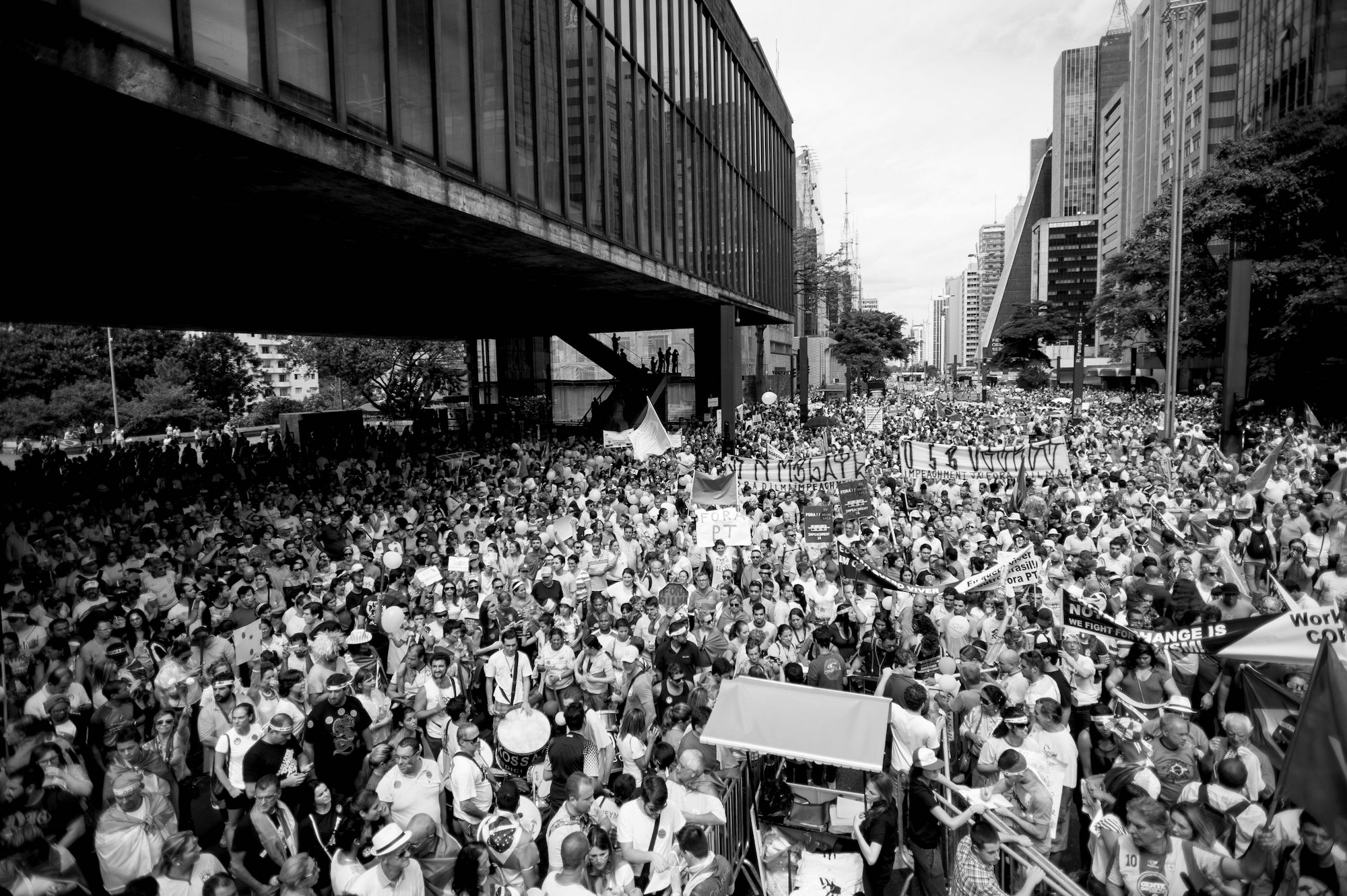
III.
During the gilded age of Lula and at the start of Dilma Rousseff’s first term, the Brazilian art world was on fire, mirroring the country’s bright economic outlook. Major institutions came out of a rut. Funding seemed to pour in from the government, and so much excess cash was going around that collectors didn’t seem to mind digging into their pockets to make big donations. This money heralded a new moment in the art scene, giving gallerists, curators, and artists the sensation that Brazil was finally becoming a powerful global player. This new confidence was reflected not only inside Brazil, but outside too. In 2000, three of Oscar Niemeyer’s buildings in São Paulo’s Iribapuera Park were commandeered for “Mostra do Redescobrimento,” a massive celebration of Brazilian art that favored high-drama spectacle (such as a forest of artificial trees) over art historical rigor. A few months before 9/11, much of the exhibition traveled to New York’s Guggenheim Museum and became “Brazil: Body and Soul,” an unprecedented, budget-busting survey (sponsored by a phalanx of newly minted Brazilian millionaires) of Brazilian art, for which Frank Lloyd Wright’s spiral was dramatically painted black.
The Bienal de São Paulo came back full-throttle at the hand of entrepreneur Heitor Martins, and was reformed and reestablished as the main anchor of Brazil’s art institutions. Martins and some of his friends in the country’s biggest banks also helped rebuild the Museu de Arte de São Paulo, ousting an old administration that had sunk the Lina Bo Bardi-designed museum into complete irrelevance. Curator Adriano Pedrosa’s first move as he took over the institution was to reinstate the famous glass easels that Bo Bardi designed to display the museum’s collection. These transparent displays, which allowed for a non-linear representation of the history of art instead of the standard European succession of styles and schools, were an iconic feature of the museum’s architecture in the early 1960s; the old administration had removed them. Their return sent a clear message that Brazil’s artistic future was still deeply rooted in the utopia of the country’s postwar modernist heyday, despite the dictatorship that had abbreviated it.
The feeling before the bubble’s burst was of such freedom and economic strength that even politicians felt at ease returning to a tropicalist state of mind. One clear sign of this: the São Paulo state government’s decision to transform the Niemeyer building used to house the city’s transit authority into a museum. The Museu de Arte Contemporânea da Universidade de São Paulo, just across the street from the Bienal building, underwent a substantial renovation and became home to some 8,000 works of art, bringing to light a string of Modigliani, de Chirico, and Picasso paintings previously stored in a back lot at the state’s university.
As Rio geared up for the Olympics, three huge new public museums also went into construction. The Museu de Arte do Rio and starchitect Santiago Calatrava’s Museu do Amanhã (Museum of Tomorrow) arose along the city’s revamped old port. The Museu da Imagem e do Som, designed by New York firm Diller Scofidio + Renfro, also started to take shape on Copacabana Beach.
Zurich’s Daros Collection spent nearly $20 million renovating an old convent in Botafogo, a leafy enclave in south Rio just a stone’s throw from Sugarloaf Mountain, and brought masterpieces of its Latin American art collection to wow local audiences. In São Paulo, British gallery White Cube also opened a space. Both Casa Daros and the White Cube outpost, flooding local collections with Tracey Emin neons and Damien Hirst paraphernalia, surfed on the high tide of the economy.
As museums and galleries flexed their newly toned muscles, Brazilians grew accustomed to blockbuster shows. While the local currency enjoyed relative stability and gained parity with the dollar—a phenomenon that marked the beginning of those extravagant economic times — major collections made their debut in Brazil. Works by Dalí, Kandinsky, Ron Mueck, Yayoi Kusama, Ai Weiwei, Marina Abramović, and Renaissance masters drew huge crowds to museums. These star-studded shows catapulted São Paulo and Rio to the top of museum world attendance figures, increasing foreign attention to the country’s artistic boom.
But nothing in these glamorous times shone brighter than the Instituto Inhotim. Bernardo Paz’s theme park of a museum, in the middle of the jungle just outside Belo Horizonte, became a soft power success for booming Brazil, wooing such foreigners as Chris Burden, Anish Kapoor, Olafur Eliasson, Janet Cardiff, Cristina Iglesias, Matthew Barney, Doug Aitken, and other art world darlings to build site-specific pavilions in the middle of Burle Marx-landscaped fields. Budgets were sky high, and the park had quadrupled in size since its inauguration ten years ago. Dubbed the “Jurassic Park of the arts,” Inhotim never saw a moment of skepticism during those moments of expansion. No one, it seemed, could have predicted its downfall, much like the characters in Spielberg’s film, who gave little thought as to what would happen should the dinosaurs break loose.
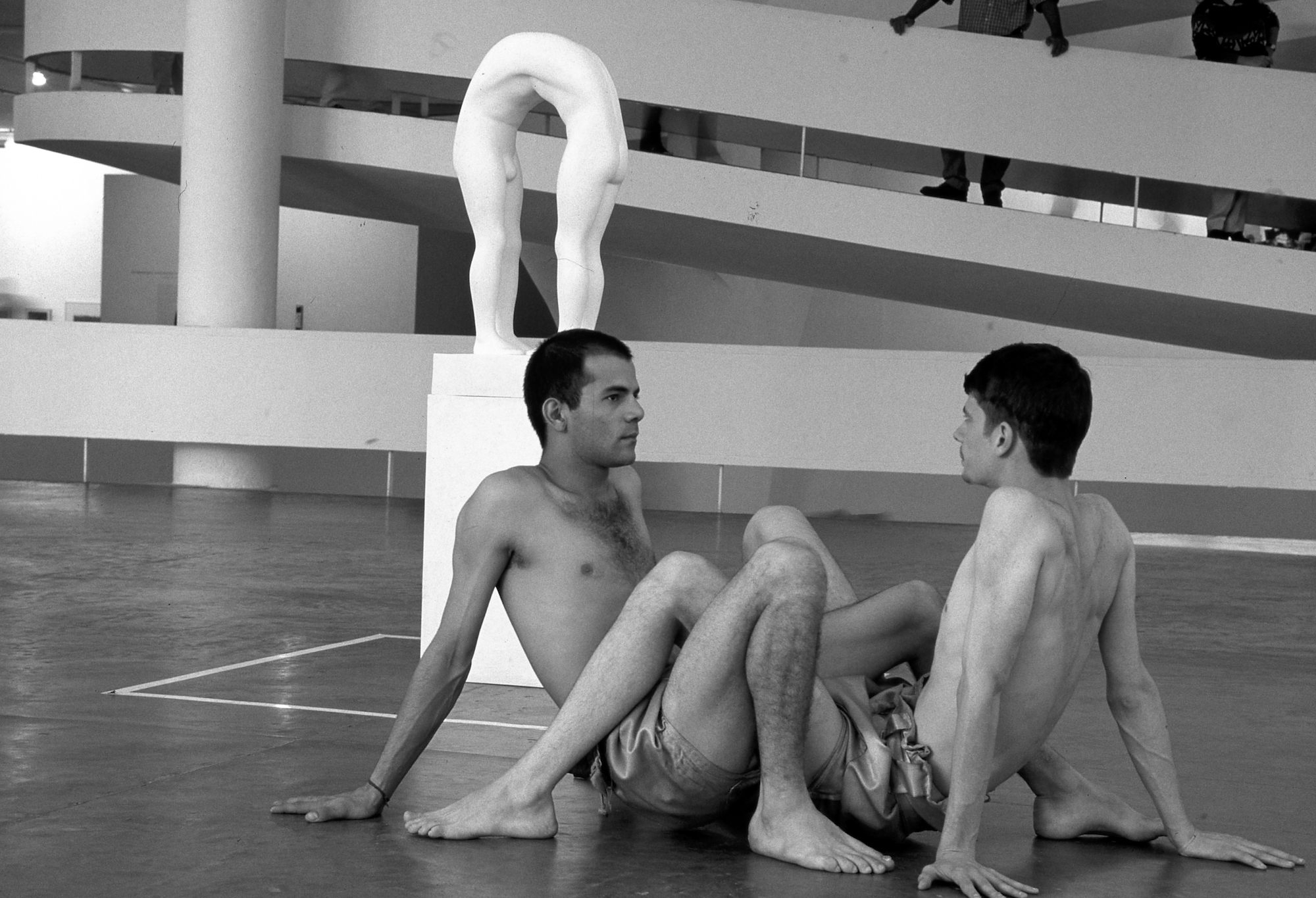
IV.
The grandiose dreams of Brazil’s art world, as well as the flashy veneer of newly opened museums and galleries, began to crumble and fade as the economy weakened. The downturn came faster than anyone predicted, proving those who thought the country immune to the global crisis were flat-out wrong.
When the contemporary art museum at the Universidade de São Paulo took over the Niemeyer building in 2012, its rooftop terrace, café, and museum shop at the mezzanine level were the only things left to finish. Four years later, there are no funds in sight to complete the job. The rooftop is now a deserted viewing platform, much like the rest of the museum. Unable to fund its own temporary exhibitions, MAC, as it is known here, remains empty most of the day.
From its terrace, one can spot the Bienal building, Oscar Niemeyer’s hut-shaped pavilion, as well as the Museu de Arte Moderna de São Paulo. While the Bienal tentatively gears up to host its 32nd edition this year, the Niemeyer and MAM are also victims of the stifling economic crash. What was supposed to be the new Museu da Cidade, an institution dedicated to displaying the city of São Paulo’s art collection, is now an empty shell. Smothered by state bureaucracy, the director of the museum quit after trying to put together a program without funds. In the meantime, MAM, once one of the most active museums in the country, has ditched most of its temporary shows and has chosen instead to display its own collection in a series of rehangs that disguises the real drama it faces. Traditionally, it would have prepared a major exhibition to parallel the Bienal de São Paulo. This year will see yet another rearrangement of its own works.
All across the country, museums began to close, like dominoes tumbling one after another. The Museu Paulista, São Paulo’s historic museum, was shuttered three years ago when engineers warned its roof might collapse from lack of conservation. It hasn’t reopened since. Its directors cannot even predict when repairs will start, meaning no one knows whether it will see the light of day again. Some of the Museu Paulista’s masterpieces were removed and transferred to the Pinacoteca, one of the few museums still in good shape in the country, even though its program is likely to suffer as the crisis aggravates.
The Paço das Artes, an art space celebrated for a program featuring young, up-and-coming artists, was evicted from its brutalist building on the University of São Paulo campus and has no place to go. State authorities responsible for the institution are now considering moving into the Praça Victor Civita, another cultural center that has folded in these difficult times. In the meantime, Paço’s exhibitions are being hosted wherever curators can find a space — a Lenora de Barros retrospective opened at the Oficina Cultural Oswald de Andrade, in downtown São Paulo, and another series of shows will occupy a small room on the ground floor of the Museu da Imagem e do Som. To fend off the crisis, this museum also changed its program, leaving behind experimental video and lm shows to host blockbuster, pre-packaged exhibitions, like a Tim Burton retrospective recently on view with record attendance.
On the surface, as the Burton show might make you believe, things appear normal. But the rapidly decaying situation of museums in Brazil, especially the public institutions battling for the leftovers of contracting state budgets, seems to confirm the troubling pertinence of an observation Claude Lévi-Strauss made in the 1930s. When the French anthropologist visited São Paulo, he remarked that “here everything looks like it is under construction, but it is already in ruins.”
Indeed, even before Santiago Calatrava’s Museu do Amanhã opened in Rio, parts of its tortoise-like metallic shell had already rusted, like a corpse decomposing under the sun. Not far from there, in Copacabana, the Museu da Imagem e do Som’s Rio outpost was said to be sinking into the soft ground near the beach before its top floors were even completed. The basement of the Museu de Arte Contemporânea da Universidade de São Paulo, intended for the storage of artworks, showed signs of flooding and infiltration even while the white paint on its walls was still wet.
Another disaster zone: São Paulo’s central Luz district, which was bulldozed years ago for the construction of a dance theater designed by the Swiss firm Herzog & de Meuron. Impressive, stark white renderings of the project — picture a panoply of concrete slabs piled up in mesmerizing layers — circulated widely in the press. After years of delays, the state government decided to scrap its construction, saying there was no money to build it. The gaping hole left in the urban fabric is now home to crack addicts, meaning a new slum has emerged where sophisticated plays and ballets were to be performed.
When Casa Daros announced it would close last year, one of the reasons given was what economists have historically labeled “the Brazil cost.” The Swiss collectors concluded, just as so many others have over the past decades, that the country is too expensive to function. While state bureaucracy stultifies growth and taxes are overbearing, social inequality seeps to the surface even in districts earmarked for gentrification, like São Paulo’s Luz or Rio’s old port. Even though nearly 30 million were lifted out of poverty during the Lula years, Brazilians still think of themselves as undeserving of “cosmetic” art endeavors while so much of the country is still a wasteland of peril and injustice.
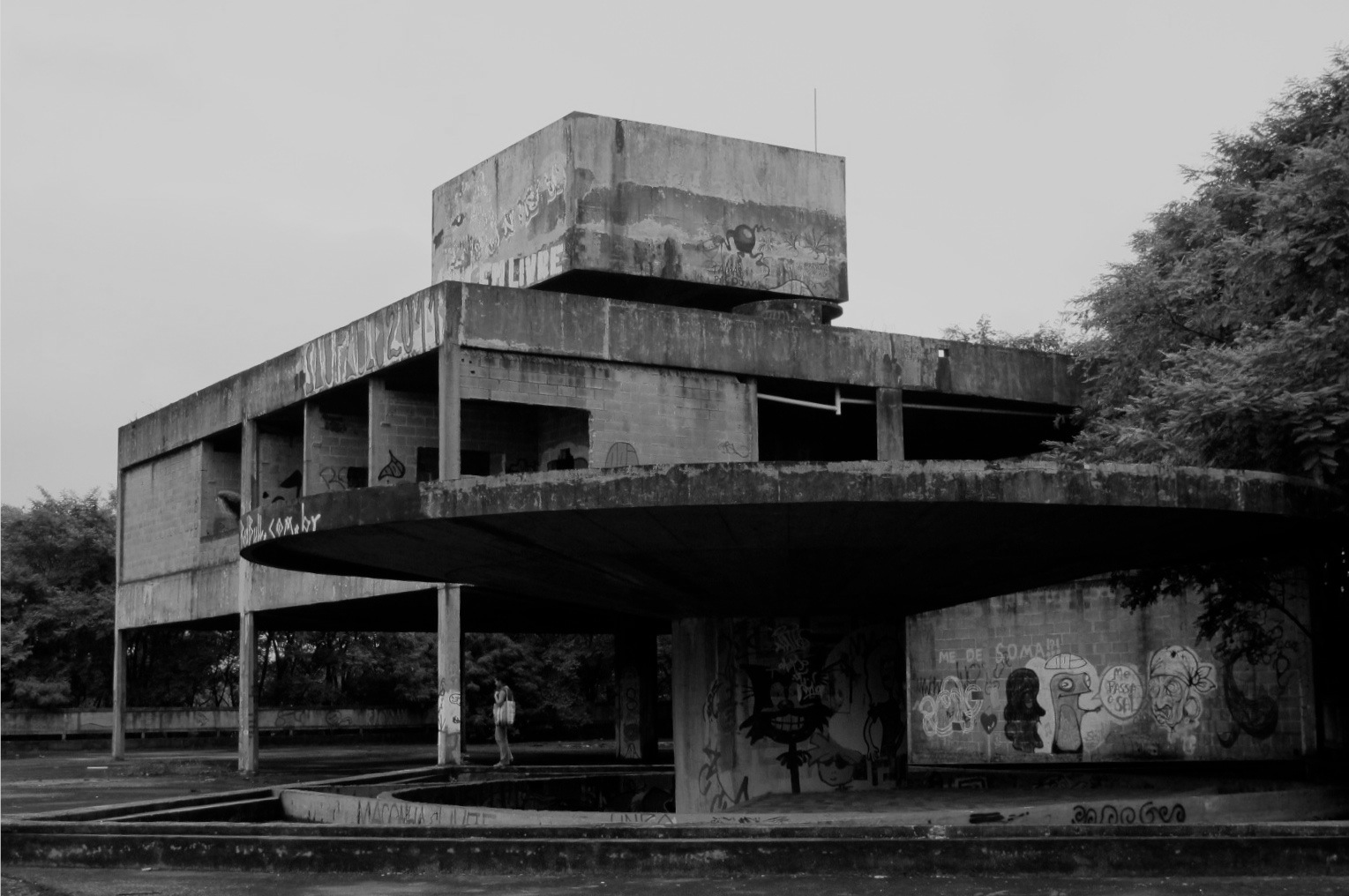
V.
When the São Paulo state government evicted the Paço das Artes, after five years of rumors to that effect, they gave a very timely reason: the state had to convert the building into a vaccine factory. The Zika fever virus, a rampant epidemic causing birth defects in babies all over Brazil, is the latest and most severe of numerous public health crises that had already alarmed the nation. With the eviction of Paço, Zika strangely made its way into the art world, clearing out a museum so that scientists could work on saving lives.
Before Dilma Rousseff’s impeachment process began, Zika was all over the headlines. Many collectors put off their travels to Brazil in fear of the deadly virus. Major foreign dealers, such as Larry Gagosian and Marian Goodman, dropped out of SP-Arte’s lineup to avoid the economic recession, and perhaps also the still baffling illness. The rhetoric adopted by bureaucrats and politicians was that contemporary art was simply not above health concerns in the hierarchy of troubles facing the country, which justified scrapping an arts institution in the name of an effort to eradicate a virus that was claiming lives.
A dry spell and high atmospheric pressure also trapped enormous amounts of heat around southeastern Brazil, making São Paulo and Rio unseasonably hot this southern fall. The arid weather and dearth of rain contributed to an earlier than usual surge of the H1N1 fever virus, another disease that has plagued urban dwellers. As the country moved to produce more and more batches of vaccines, strange class divisions began to show, with measures that jarringly hark back to colonial times. Some hospitals and clinics were sued by the health authorities for hiking prices on standard vaccines. Major banks negotiated with laboratories and offered VIP access to immunization to their preferential clients, a move reminiscent of the rules onboard the Titanic, where the rich escaped without harm and the poor drowned.
Yet these are strange days in Brazil, and nothing seems to raise any suspicion. The horrendous economic outlook has actually served as a handy rhetorical foil for decisions to give up on major cultural plans. When the governor of São Paulo announced the cancellation of Herzog & de Meuron’s lavish dance theater in the city center, there was almost no outcry, as though advocating for culture in such times of turmoil were rather selfish and naïve. The idea that desperate times call for desperate measures seems to justify the postponement of anything artistic.
That is certainly the mood in corporations all over the country. Brazil’s famed Rouanet Law allows companies and investors to divert part of their tax payments to cultural initiatives, but the program has never seen such a drastic fall in funds, as CEOs have one by one concluded that supporting the arts in this moment of crisis would be seen as frivolous at best, heartless at worst. This mood swing—coupled with the economic recession, which caused commodity prices to plummet—has drained resources previously destined for arts institutions. Museums have had to drop exhibitions from their lineups, reduce opening hours, or even close temporarily.
Among those hit the hardest: the Instituto Inhotim, in the jungle just outside Belo Horizonte, and the Fundação Iberê Camargo, the Álvaro Siza-designed museum in the southern city of Porto Alegre. Both rely heavily on cash from exports of iron; Inhotim is financed by the state- owned mining company Vale and collector Bernardo Paz’s own Itaminas holding, and the Fundação Iberê Camargo is supported by steel giant Gerdau. Neither has even announced a program of exhibitions for this year. While the Porto Alegre institution scrapped plans to display works by its namesake painter in a string of European capitals, Inhotim has put on hold new pavilions designed to show the work of artists such as Olafur Eliasson, Anish Kapoor, Ernesto Neto, and Nuno Ramos.
This new economic reality — in which state juggernauts have lost all influence — is dominated by private banks such as Itaú and Bradesco, which have had to rethink their philanthropic strategies as the markets reel and as a fair helping of their clients face criminal investigation. It is their marketing departments that now determine what becomes reality and what will remain on hold. Itaú, a major backer of the Bienal de São Paulo, the Museu de Arte de São Paulo, the Museu de Arte Moderna, and Itaú Cultural (its own cultural center on Avenida Paulista), has resorted to a more “streamlined” approach to funding. Bradesco has also grown stingier lately, backtracking on its decision to support a major Picasso retrospective to be held at the Instituto Tomie Ohtake.
The shift in cultural funding from massive state enterprises to private corporations also means a significant change in the nature of the projects that make it through the red tape. Companies such as Vale and Petrobras, once the biggest sponsors in the nation, did not care what kind of exhibition, play, movie, or musical they were supporting, as long as the right percentages of what they owed in tax got deducted. Whereas Itaú, Bradesco, and communications giants like Vivo and Oi pick and choose what to underwrite according to careful consideration of their marketing teams. That means only projects with commercial appeal or easy glamour can pick up a check — such as the recent shows of David Bowie at the Museu da Imagem e do Som, or Marina Abramović’s retrospective at SESC Pompeia, complete with the artist’s “method” taught to audiences by a team of assistants.
This is bad news for artist-run spaces and alternative cultural centers, such as Pivô, Ponto Aurora, Solo Shows, and Phosphorus. Four of the most vibrant new arts addresses in downtown São Paulo, these smaller spaces came of age during the economic bonanza, financed by generous patrons, new collectors, and artists themselves. Their lifeline, however, has begun to dry up as the economy sinks further, meaning the future of the art scene here is likely to center around big, commercially oriented projects as corporations become the real curators in the Brazilian art world.

VI.
In the heyday of Brazil’s modernist utopia, with president Juscelino Kubitschek’s “50 years in five” objective fueling the construction of Brasília and industrialization efforts all across the country, the Bienal de São Paulo opened its first edition. It remains the longest-running show of its kind after the Venice Biennale, and survived even the most brutal years of the military dictatorship, recovering its explosive power and influence with the country’s return to democracy in the 80s. Today, it has mostly resisted our economic woes, and the Bienal de São Paulo will hold its 32nd edition this year. Aptly named “Live Uncertainty,” as though it were broadcasting live from Brasília, it will feature mainly younger artists, with a third of its lineup born in the 1980s, and will center on themes of environmental disasters, displaced and marginalized populations, and political turmoil all around the world.
The market here only caught up with the country’s nonprofit institutions by the beginning of the 21st century, with the inception of SP-Arte, which in turn was only made possible after a more robust gallery circuit had been established. SP-Arte just came to a close with a significant drop in revenues, and ArtRio looms on the horizon after this August’s Olympics as a final test of where the market is headed.
When Brazil was on the rise, before the crash that now has a stranglehold on the nation, it seemed to bolster a whole regional scene along with it, strengthening ties between São Paulo and Rio de Janeiro and other Latin American capitals, from more established Buenos Aires and Mexico City to newcomers like Bogotá and Lima. The Mexican capital is now charging ahead with ever more extravagant endeavors: museums like Soumaya and Jumex, the surging Zona Maco fair. The Argentine metropolis, meanwhile, may stand to benefit from a much-needed attitude makeover now that the Kirchner years have come to a close and the less strident Mauricio Macri has assumed the presidency. The Colombian and Peruvian capitals, while hotbeds of artistic talent, have much to gain in maturity and have not yet shown an institutional consistency to stand up as real rivals to Brazil, even in times of such heavy turbulence.
Foreign eyes may now be searching for the “new Brazil,” but it remains a fact there is no collector base as strong as São Paulo’s and Rio’s anywhere in Latin America. Only Mexico City comes close, yet despite the power of galleries like Kurimanzutto, magnates like Eugenio López and Carlos Slim, and a convenient address next to the United States, it still lags somewhat behind. We can only hope that the breadth of Brazil’s collector base means that a revival in the local art world’s fortunes is just a matter of time — an undeniably difficult interval, it’s true, but an opportunity for careful and steadfast housekeeping. This means galleries without a solid team of artists will most likely disappear, with a new, more streamlined scene as a future recovery kicks in. The Museu de Arte de São Paulo, under Adriano Pedrosa’s stewardship, has made a point of uncovering previously muted passages of the country’s art history, especially the neglected legacies of black, indigenous, and outsider artists. Emerging galleries like Jaqueline Martins are also digging into our recent history to bring to light pioneers of queer art and video experimentation.
Better days will come. For today, two works of art I saw in the last year seem to encapsulate Brazil’s present adversity. One I saw in Belo Horizonte, where the artist Nuno Ramos built a monument to our tattered country: he filled the cavernous atrium of the Centro Cultural Banco do Brasil with a huge scaffold, and installed strange flutes around the iron girders. At decelerated tempo, the flutes played Tom Jobim’s “Samba de Uma Nota Só,” one of bossa nova’s sunniest and blithest compositions, which here sounded more like a death march. It seems Ramos agreed with Claude Lévi-Strauss’s old idea that in Brazil, everything looks as if is still under construction but is already a ruin. The artist upended the most optimistic and carefree emblems of our 1950s daydream to create a brutal nightmare, an iron skeleton that screeches and grinds to a halt. In a way, this is Brazil today: a country stolen from my generation, the first born under democracy.
The other I only saw online. When Congress voted to oust the president back in April, an artist posted on Facebook a picture of a rare painting, one of two in which Oscar Niemeyer himself painted Brasília in ruins. The architect surely created this apocalyptic vision as a joke, a bit of wry humor. Now ruination is all too actual, as the caste of Brasília has destroyed most of what’s left of democracy in this country and brought the old elite — one relying on what Brazil calls BBB, “bullets, Bibles, and bulls” — back into power. Days here blend into one another, politics keeps getting sloppier and scarier, and no one, artists, critics, and gallerists alike, knows what the future will look like. Brazil is over — for now.